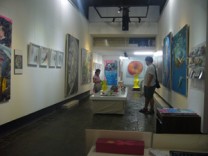您所在的位置:One gallery>画廊动态>正文
Visual Fest (Part One)
2011-04-15 11:33:10
In Italian, the slogan for the 52nd International Exhibition of the 2007 Venice Biennale, June 10-Nov. 21, 2007 -- "pensa con i sensi, senti con la mente" -- sounds like an advert for a breath mint. In English, that’s "think with the senses, feel with the mind" -- and just plain bad advice.
The Italian pavilion, the warren of galleries that hosts the main part of the exhibition, features individual rooms filled with works by curator Rob Storr’s usual suspects -- Gerhard Richter (a particularly gummy assortment of smear abstractions), Louise Bourgeois (a grid of not-half-bad grid drawings done in blue pen), Ellsworth Kelly (they looked better a few months ago at his New York gallery), Robert Ryman, Nancy Spero, Kara Walker, Susan Rothenberg, Thomas Nozkowski.
Sigmar Polke gets pride of place in the pavilion’s grandest gallery, with a suite of very large paintings made of glistening, alchemical resin on some kind of transparent support, so that the stretcher bars are half-visible. The pictures are dark brown, the color of Worcestershire sauce. Most are only marginally inflected, but two reproduce 19th-century woodcut images of explorers, presumably looking out to a very muddy future.
Jenny Holzer contributes a room full of new paintings, blow-ups of censored documents, works that appear to marry a conceptual artist’s interest in text with a latter-day Neo-Expressionism. Holzer is finally moving away from those tiresome maxims. Somehow, it’s not surprising that Storr is encouraging her in this regard.
The punk cartoonist Raymond Pettibon contributes a particularly listless room -- didn’t he do an installation here before? -- as if he had decided that it would be easier to be a graffiti artist and work on a large scale than to make all those intimate, labor-intensive drawings. It reminds me of Basquiat, with its Tourette-like outburst of scattered found texts, including one that’s anti-Semitic.
Even the late, much-missed Sol LeWitt seems to bend towards a utopian end, as his Wall Drawing #1167, Dark to Light (Scribbles) (2005), resembles a mystical orb painting by Richard Pousette-Dart.
Despite all this, people actually seem to like the Italian pavilion, saving their scorn for the second part of the show, which is installed in the long, almost endless gothic brick hall that is the Arsenale.
Perhaps it’s the "politics." Paolo Canevari (b. 1963), a Roman artist who also lives in New York, screens a 12-minute vid of a kid playing soccer with a rubber skull in the ruins of Belgrade in 1999 (whatever that’s supposed to mean). And an 87-year-old artist from Buenos Aires, León Ferrari, contributes a supremely kitchy political statement from 1965 -- a polychromed statue of Jesus crucified on an F-111.
One gallery holds about 15 straightforward photos of soldiers from Vietnam, WWI and WWII and the Persian Gulf War, presented as if they were his own by the London-based artist Neil Hamon (b. 1975). They have a no-bullshit air about them.
The Bulgarian artist Nedko Solakov (b. 1957) covers a large swatch of wall with an amusing, hand-written tale of his attempt to interview Russian and Bulgarian authorities about a dispute between the two countries over royalties for the AK-57. In the post-Soviet world, Russia wants Bulgaria to pay a fee for producing the very popular Russian rifle. In the end, Bulgaria declines, noting that Russia pays nothing for its use of yoghurt and the Cyrillic alphabet, both devised in Bulgaria.
I actually like this kind of stuff, though you often hear art-world types disparaging anything that resembles political art. They prefer artists like Y.Z. Kami, who has two giant portraits of white people with their eyes closed, which here seem like an emblem of curatorial dim-out. Overall, the selection of artists shows that the art-world’s utopian modernism is increasingly fraying at its Third World edges.
Then there’s the huge room filled with dangling neon signs in bright colors, all spelling out different slang words for "pussy" -- here done Italian-style -- by Jason Rhoades, who died suddenly last year after a night of partying. It’s hard to see how this demented Dionysius fits in, since in his case it’s probably safe to see his unbridled hedonism as a cautionary tale.
Most interesting of all is the new African pavilion, a nicely proportioned rectangular hall with an s-shaped floor plan. Since the works are all from the collection of the controversial Luanda-based businessman Sindika Dokolo, the show -- "Check List Luanda Pop" -- represents a distressing abrogation of curatorial responsibility, not to mention a blatant privatization of the biennale’s otherwise public independence. (Is Charles Saatchi wondering how he can get in on this deal?)
Still, the pavilion supposedly represents the first African show of African art at the biennale in its 100-plus years -- though it’s hardly focused on black Africa, since a good portion of the work comes from artists who are African-American (Jean-Michel Basquiat, DJ Spooky) or white (Marlène Dumas) or from north Africa (Ghada Amer) or who live in the West (Chris Ofili) or who are not remotely African at all (Andy Warhol).
Africa is the World. But that’s actually a good thing in the global 21st century, making "national" boundaries more porous, indeed, more meaningless. Isn’t it?

 黄琦
黄琦 测试用艺术
测试用艺术
